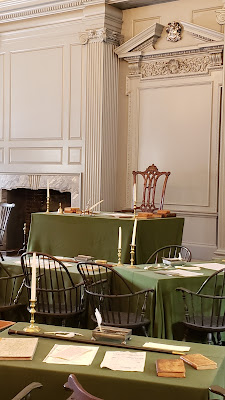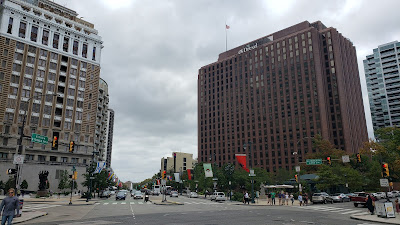Visited: Sept 2019
Nearby city: Philadelphia, PA
"I have often, in the course of the session, looked at that sun behind the President without being able to tell whether it was rising or setting. But now at length I have the happiness to know it is a rising and not a setting sun."
-Benjamin Franklin, September 17, 1787, as the Constitution was being signed, commenting about the carved sun on the back of the chair used by the President of the Convention
Philly. The City of Brotherly Love. The Athens of America. Philadelphia, Pennsylvania is the home of many of America's firsts: library, hospital, medical school. Philadelphia also served as the nation's first capital. Today, certain parts of downtown are protected as Independence National Historical Park. It preserves many historically significant sites that were critical to America's independence from Britain and the formation of the federal government.
The centerpiece of the Park is Independence Hall.
This Georgian-style red brick building served as the seat of State government and was completed in 1753.
Independence Hall was the location of two momentous events in America's early history: (1) signing of the Declaration of Independence in 1776; and (2) formation of the US Constitution in 1787.
The Hall's steeple was also the original home of the famed Liberty Bell. The iconic bell was commissioned in 1752 and was cast with the lettering "Proclaim LIBERTY throughout all the land unto all the inhabitants thereof." The bell was ceremoniously rung to mark the reading of the Declaration of Independence, for many years the story was told that the bell was rung on July 4, 1776 - but it's more likely that it was rung at the public reading a few days later, on July 8. The bell developed its distinctive crack sometime in the early 1800s. The bell would be taken around the country for people to see, but as more cracking and damage occurred, its last nationwide tour was 1915. The bell's permanent resting place is now at the Park museum/visitor center across the street from Independence Hall. The bell has become a symbol of not only the city, but the nation as a whole.
The Hall is open to the public, but you must tour it with a guide. Head to the visitor's center early in the day and get your ticket.
The Hall has two large rooms, one in each wing: (1) the Assembly Room; and (2) the Supreme Court Room. Independence Hall served as the principal meeting place for the Second Continental Congress from 1775-1783. The Continental Congress was a body of representatives from each of the thirteen colonies. In June 1775, the Continental Congress nominated George Washington as commander-in-chief of the Continental Army. On July 4, 1776, the Congress approved the Declaration of Independence. The declaration, primarily drafted by Thomas Jefferson, officially declared the colonies independent from Great Britain, listed the grievances against British authority and justifications for revolution, and outlined the natural rights, ideals and guidelines of the new government that the colonies intended to form.
"We hold these truths to be self-evident, that all men are created equal, that they are endowed by their Creator with certain unalienable Rights, that among these are Life, liberty, and the Pursuit of Happiness. That to secure these rights, Governments are instituted among Men, deriving their just powers from the consent of the governed..."
-from the Preamble of the Declaration of Independence
After the hostilities of the American Revolution ended and Britain recognized the colonies' independence in the Treaty of Paris in 1783, the new government struggled enormously. The first governing framework of the nation, the Articles of Confederation, proved inadequate in facilitating trade and commerce between the new states, and also between the states and foreign powers. The economic situation was dire. It led to populist uprisings such as Shays' Rebellion in Massachusetts.
Delegates from the respective states met at Independence Hall in the spring/summer of 1787 to discuss ways to amend and improve the Articles of Confederation to deal with these problems. As the debate at the Convention raged on, the delegates came up with essentially an entirely new constitution to replace the Articles. James Madison of Virginia was instrumental in the drafting and formation of this Constitution. The Constitution created a strong federal government, made up of three branches - a (1) bicameral legislature, (2) executive, and (3) judicial. Each branch had separate powers, and served as a check on the other branches. The delegates realized that the Constitution was a result of compromise and was not perfect. Therefore, a mechanism was developed in the document itself to amend it.
At the closing of the Convention, the most senior delegate, 81-year old Benjamin Franklin, commented:
"I confess that there are several parts of this constitution which I do not at present approve, but I am not sure I shall never approve them: for having lived long, I have experienced many instances of being obliged by better information, or fuller consideration, to change opinions even on important subjects, which I once thought right, but found to be otherwise. It is therefore that the older I grow, the more apt I am to doubt my own judgment, and to pay more respect to the judgment of others. ...
I doubt too whether any other Convention we can obtain, may be able to make a better Constitution. For when you assemble a number of men to have the advantage of their joint wisdom, you inevitably assemble with those men, all their prejudices, their errors of opinion, their local interests, and their selfish views. From such an assembly can a perfect production be expected? It therefore astonishes me, Sir, to find this system approaching so near to perfection as it does."
The Convention was completed on September 17, 1787, and then the Constitution was ratified by the states and took effect on March 4, 1789. By 1789, the capital had moved to New York City, and that is where the first Congress met. George Washington was elected as the first President. The Congress then moved to Philadelphia in 1790, and then finally to it's current home, the newly-built capital of Washington DC in 1800.
Once your tour is complete, make sure to head to some of the other areas of the Park, which are all within walking distance from Independence Hall. Sites include: (1) Carpenters' Hall - the meeting place for the First Continental Congress in 1774; (2) Dolley Todd House - home of the future First Lady, Dolley Madison; (3) Free Quaker Meetinghouse; (4) Old City Hall - first home of the US Supreme Court; (5) Second Bank of the United States; (6) Benjamin Franklin's grave; and many other sites, buildings, and museums.
cemetary where Benjamin Franklin is buried
south side of Independence Hall
Dolley Todd house
Carpenters' Hall
Benjamin Franklin's grave
There are also lots of sites to see around the beautiful city of Philadelphia. Great architecture. We stopped by Reading Terminal Market, walked around downtown, the "Rocky" steps, and the Philadelphia Museum of Art.
Reading Terminal Market
Philadelphia City Hall
City of Brotherly Love
Rodin Museum - contains large collection of works by the great sculptor, Auguste Rodin (1840-1917)
Philadelphia Museum of Art, these steps were immortalized in the 1976 film "Rocky"
We enjoyed our time in Philadelphia. For more info: https://www.nps.gov/inde/index.htm


















































No comments:
Post a Comment